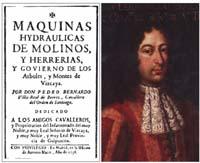Dams with kicks, works of an autodidacta
Pedro Bernardo Villarreal de Berriz, however, began to build a variant of these dams: he dedicated himself to the construction of dams with stirrups or buttresses. That is, dams with stirrups at the bottom. The dam wall can be straight or vaulted.
The laying of stirrups on the dam wall allows to make a thinner wall, reducing the use of materials, saving material. Or you can give more height to the wall and collect more water in the reservoir. The water forces the prey, the dams direct that force towards the ground and the kicks.
With this type of rush, Pedro Bernardo managed to gather more water and, therefore, gained more strength in his ferns to favor the production.
On the route they have recently prepared on the banks of the River Lea you can see several of their works.
Five dams
Pedro Bernardo presented in a book written by himself (we will see later) the prey with five kicks. All of them are dams of about 3,60 meters of height.
Two are in Markina, Antsotegi and Osillain (in the book of Pedro Bernardo appears with the name of Barroeta). The Antsotegi dam is located on the Urko River, on the road from Markina to Elgoibar. It is a single-arch vault or arch, with a single abutment on the left side. The Osillain or Barroeta is located on the road to Ondarroa, on the Artibai river, with two arches and a kick in the center, separating both arches.
He also mentions two dams in the area of Gizaburuaga. The Laisota has two arches and a single kick. The dam of the mill Arentzibia has three arches. According to the book, "the three arches are of different rope to take advantage of some rocks". He raised the bed on the rocks and fixed on them the stirrups.

In any case, the main dam of Pedro Bernardo is that of Bedia, of Ibaizabal. It was built in 1734 or 1735. It has five arches and four kicks that separate them. It seems that two years earlier a single arch dam had been built in the same place, but it was dragged by water, due to the excessive width of the arch.
Pedro Bernardo Villarreal de Berriz has been considered on some occasion as inventor of prey with kicks, but in the area of the Merida in Spain there are several dams with Roman stirrups. In any case, Pedro Bernardo published a work composed of three volumes in which he explains for the first time how prey with kicks are, how they should be done, measures, materials, etc.
The written work of Peter
Peter Bernard explains in his introduction the reason for his work. He says his friends pushed him to write, but since he was young he also realizes his fondness for mathematics and hydraulics. Hydraulic Machines of Mills, and Blacksmiths, and Govierno of Trees, and Mounts of Biscay , is the name of the work he published in 1736.
In the first volume, always with respect to dams, gravity dams are indicated. It says they are prey of yesteryear and then explains the system of kicks, safer, more forceful and cheaper. Also in the stirrups explains how they should be performed (measures, materials, etc.). In later chapters explains the mills.
In the second volume, dedicated mainly to the ferns and hydraulic wheels, and in the third volume, to the norms and observations for the management and government of the mountains of Bizkaia.






